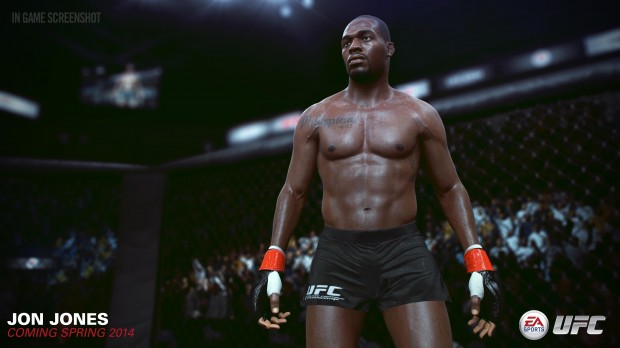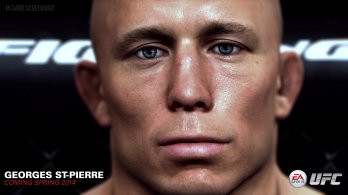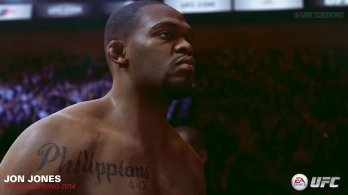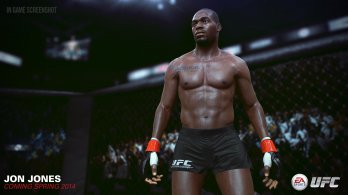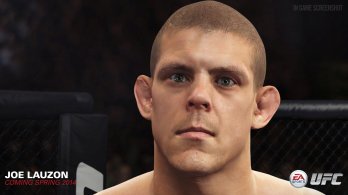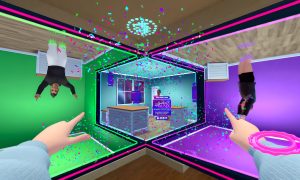I’m a bit of a UFC fan. I’ve seen fights ringside, I hold parties at my house where the cheering gets so loud you can hardly hear the Shatner-esque commentary from Goldberg, and I’ve even gotten to tangle with some of the biggest and brightest in the Octagon. When THQ debuted their UFC product I was excited, but something was always missing. Too many flash knockouts, wearing a hole in my palm from the submission system, odd glitches in animation — it never quite came together completely. EA Sports UFC is looking to change that. They want to take this ever-growing sport and truly transform it into something that matches the tagline: “As real as it gets”.
I met up with Brian Hayes, Creative Director at EA Canada, for a few rounds with an early version of EA Sports UFC. Right off the bat it was clear that this title is a next-gen vision of the UFC. The visual fidelity was unmatched by anything on the market. Each fighter has been modeled with motion capture rigs, which we’ve seen before, but this is something more than that. The power of the new platforms allowed the team to not only capture movement and looks, but also their physiology and emotion in their face. Not looking to make animated dolls with nothing behind the eyes, EA Canada went so far as to even put depth in the eyeball itself, showing a small bit of reflection of the environment on the cornea. This little bit of added detail translates into the cross-the-mat glares and exuberant victory celebrations that make the digital representations of these incredible athletes that much more real.

To achieve this level of graphical fidelity the team took headscans of all of the fighters in the game. Using a detailed animation rig, they’ve culled the individual movements unique to each subject, capturing the way they move, their signature entrance and celebration styles, facial expressions ranging from excitement to pain, and much more at a very deep level. Using dynamic lighting, subsurface scanning (this gives the appearance of skin translucence), and proprietary technology that allows muscles to flex, bend, and ripple under the power of each strike, the team has brought these people to life. The hardware once again shows its power as the the fighters, ref, ring girl, press members on the side of the ring, and many more characters were shown on screen at full detail with no slowdown. Even the small details like the spread of the toes as the fighter presses their feet into the canvas, or the wrinkling in the neck skin as fighters stretch their neck are represented here, and the results are stunning.
It wouldn’t be a UFC game without Joe Rogan, Mike Goldberg, and Bruce Buffer to bring the audio commentary to life. All three of the guys (as well as the ring girls, cutmen, and refs) are all voice captured, bringing their signature voices to the ring. Since they can mine the audio out of the real broadcasts since franchise inception in 1993, there was little in the way of repetition, and they always seemed genuinely excited about what was going on in the ring.

We squared off Jon Jones and Alexander Gustafsson to give us a simulation of UFC 165. The fighters are illuminated by dynamic lighting as they come out with their entourage, the lighting engine flowing spotlights over the cheering crowd. After Jones crawled into the cage and did his signature one-handed cartwheel to enter the ring, we switched to Gustafsson and got to see the physics and their effect on hair in the game. Gustafsson’s coif flowed with volume and bounce, as you can see in the video above. This enables fighters like Clay Guida and Benson Henderson to bring their luscious locks to the game.
The interface is simplicity itself, showing a stamina gauge, a clock, the current round, and a silhouette of a fighter in the upper corners. This character representation shows a gradiated damage model for all four limbs, the torso, and the head. Taking damage on an arm makes it less effective at blocking and striking and also causes redness and chafing. Taking repeated strikes to the legs will make your fighter move slower and with a limp, less likely to fire off a kick in a rapid fashion. Shots to the torso tend to wobble the fighter, sapping their stamina. Given that EA Canada is the team behind the Fight Night series, it’s not surprising to see such a simple yet elegant approach.
The stunning presentation aside, it was time to pick up a controller and see the game in motion. Marching the fighters in the ring, Brian Hayes gave us a preview of the striking controls. The four buttons on the controller control the four limbs on your fighter. Pushing forward or away or using L1 and R1 act as modifiers. L1 makes your fighter deliver a “heavy” version of the strike on the limb you selected. Bouncing off a cage wall, a Superman punch, a leaping knee, and other highlight reel-worthy strikes are all delivered with the more “animated” delivery via R1. Defense is as simple as holding down the right trigger to quickly block, but it’s not 100% effective. If you hold the trigger and then hit a punch or kick button to provide a high or low block you’ll stop that incoming strike, if you are quick enough to predict and intercept it.

After trading a few strikes in the octagon, Hayes pulled back the hood a bit to reveal how clean the strikes are, your stamina, the other fighter’s stamina, whether it’s a counter attack, whether it’s partially blocked, if there is damage on that location, and far more all factors together in the background, providing a hidden dice roll against your chosen fighter’s ability to stay upright.
Speaking of staying upright, it was time to take a look at the ground game. Locking up with our fighters, we took a look at the grappling system. Unsurprisingly, the mechanics reminded me of Fight Night, with the right stick making circular motions in either direction to work in the clinch. It wasn’t long before I was hip tossed to the ground with an osotogari throw to take a look at the ground game.
I hate to keep bringing up previous iterations of the UFC games, especially from other companies, but honestly nobody has done a great job with bringing the complex submission game to life. EA Sports UFC looks to change things up a bit with a minigame that, as a life-long martial artist and Master in two styles, I can definitively say best approximates the complexity of ground work.
In ground fighting, the concept is more like chess than checkers. It’s not just yanking on an extremity until the person submits to pain compliance. Certainly there are points in a fight where a trained jiu jitsu practitioner can force you to submit rather instantly, but for the most part getting into position is a multi-stage process. EA Sports UFC looks to approximate that with a basic principle that is easy to understand but difficult to master – the defender is always looking to escape, and the aggressor is always trying to shut the doors to prevent escape. As you move between guards and mount positions you’ll have to watch your opponent. If they try to transition left, the aggressor will have to hold a left trigger and push left to counter. This will make the aggressor, as an example, pin the knee down, preventing the defender from shooting out the side exit.

On the aggressor side your job is to advance your position until you can lock up your submission attempt. As you try to lock up your opponent an octagon interface will overlay the screen. The defender will press one of the four directions with their thumbstick, and the aggressor will have to match it. A progress indicator “fills up”, and if it reaches the edge then the defender has successfully escaped the attempt. If both defender and aggressor are both pressing in the same direction, the bar will cease to fill – a stalemate, if you will. Periodically a small direction indicator will briefly flash on the screen. If the defender or aggressor flick the correct direction in time, their fighter will transition to a “better” position. I put better in quotes as sometimes you have to put yourself in a worse position to prevent a submission, such as putting yourself back into full guard to prevent being “backpacked”. Similarly, pushing out of a kimura lock will not get you out of danger, just out of the fire and back into the frying pan. Fighters with more advanced training may require less transitions to reach or escape a lock, where traditional strikers might have a longer road to reach or evade a submission. Stamina and ground skill numbers will crunch in the background to determine success or failure, but more depends on your ability to read the body language of the other fighter. In the end, the submission game already feels very natural. You have to pay a great deal of attention to body position, transition direction, your exits, and any subtle movements that might betray your opponent’s intention. It feels like the exhausting real-world cat and mouse game, and the little bit of back and forth I experienced playing Brian was already a great deal of fun.
While it wasn’t ready to show off quite yet, the game will also feature a full single-player career mode. EA has partnered with UFC to provide key video footage from training camps, fighter one-on-ones, and more are all to be heavily threaded throughout the game to bring the career mode to life. Your first fight might be punctuated by a “Welcome to the UFC, kid” from Dana White (and I know you just read that in his voice), whereas your first belt victory could be a quick note from a former champion about how difficult it is to stay at the top because everyone wants a piece of you now. Milestones, training opportunities, new gear, clothing sponsorships, and more should round out the experience. The game will also feature a suite of online modes including quickmatch – a mode similar to the FIFA matchmaking system. The quickmatch system will rank fighters by belt colors to ensure that white belts aren’t tangling with black belts. There will also be a rivalry mode that allows you to declare war on your online friends, as well as social media and video integration, but we’ll hear more on that as we approach the release date.

EA Canada has done amazing work with EA Sports UFC – they are clearly very passionate about the sport. Small details like cuts and bruises, Hendricks combing through his beard, jumping off the cage, getting correct collision on a single leg shoot, parrying incoming kicks, and proper hip positioning for a throw aren’t easy to capture, but the team is clearly committed to making this game “As real as it gets.” From what I’ve seen so far, EA Sports UFC may be the best UFC game yet!
Look for our continued coverage of EA Sports UFC as we approach the “late spring, 2014” release date on Xbox One and PlayStation 4. Check out the screenshot gallery below for all of these images in incredible high-resolution glory.
Ron Burke is the Editor in Chief for Gaming Trend. Currently living in Fort Worth, Texas, Ron is an old-school gamer who enjoys CRPGs, action/adventure, platformers, music games, and has recently gotten into tabletop gaming.
Ron is also a fourth degree black belt, with a Master's rank in Matsumura Seito Shōrin-ryū, Moo Duk Kwan Tang Soo Do, Universal Tang Soo Do Alliance, and International Tang Soo Do Federation. He also holds ranks in several other styles in his search to be a well-rounded fighter.
Ron has been married to Gaming Trend Editor, Laura Burke, for 28 years. They have three dogs - Pazuzu (Irish Terrier), Atë, and Calliope (both Australian Kelpie/Pit Bull mixes), and an Axolotl named Dagon!

See below for our list of partners and affiliates:
